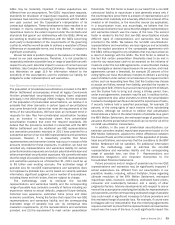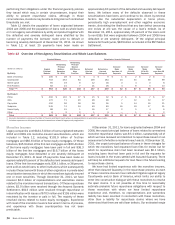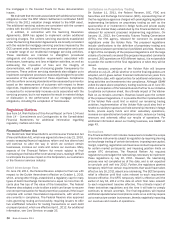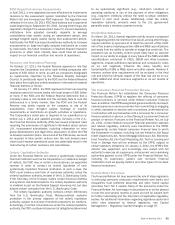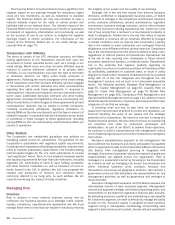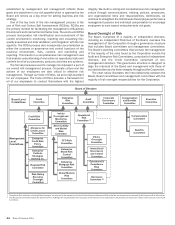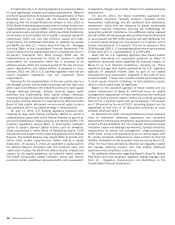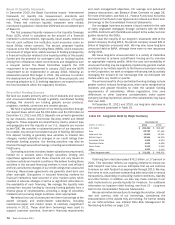Bank of America 2011 Annual Report Download - page 64
Download and view the complete annual report
Please find page 64 of the 2011 Bank of America annual report below. You can navigate through the pages in the report by either clicking on the pages listed below, or by using the keyword search tool below to find specific information within the annual report.62 Bank of America 2011
The Financial Reform Act will continue to have a significant and
negative impact on our earnings through fee reductions, higher
costs and new restrictions, as well as reductions to available
capital. The Financial Reform Act may also continue to have a
material adverse impact on the value of certain assets and
liabilities held on our balance sheet. The ultimate impact of the
Financial Reform Act on our businesses and results of operations
will depend on regulatory interpretation and rulemaking, as well
as the success of any of our actions to mitigate the negative
earnings impact of certain provisions. For information on the
impact of the Financial Reform Act on our credit ratings, see
Liquidity Risk on page 70.
Transactions with Affiliates
The terms of certain of our OTC derivative contracts and other
trading agreements of the Corporation provide that upon the
occurrence of certain specified events, such as a change in our
credit ratings, Merrill Lynch and other non-bank affiliates may be
required to provide additional collateral or to provide other
remedies, or our counterparties may have the right to terminate
or otherwise diminish our rights under these contracts or
agreements. Following the recent downgrade of the credit ratings
of the Corporation and other non-bank affiliates, we have engaged
in discussions with certain derivative and other counterparties
regarding their rights under these agreements. In response to
counterparties’ inquiries and requests, we have discussed and in
some cases substituted derivative contracts and other trading
agreements, including naming BANA as the new counterparty. Our
ability to substitute or make changes to these agreements to meet
counterparties’ requests may be subject to certain limitations,
including counterparty willingness, regulatory limitations on
naming BANA as the new counterparty, and the type or amount of
collateral required. It is possible that such limitations on our ability
to substitute or make changes to these agreements, including
naming BANA as the new counterparty, could adversely affect our
results of operations.
Other Matters
The Corporation has established guidelines and policies for
managing capital across its subsidiaries. The guidance for the
Corporation’s subsidiaries with regulatory capital requirements,
including branch operations of banking subsidiaries, requires each
entity to maintain satisfactory capital levels. This includes setting
internal capital targets for the U.S. bank subsidiaries to exceed
“well capitalized” levels. The U.K. has adopted increased capital
and liquidity requirements for local financial institutions, including
regulated U.K. subsidiaries of non-U.K. bank holding companies
and other financial institutions as well as branches of non-U.K.
banks located in the U.K. In addition, the U.K. has proposed the
creation and production of recovery and resolution plans,
commonly referred to as living wills, by such entities. We are
currently monitoring the impact of these initiatives.
Managing Risk
Overview
Risk is inherent in every material business activity that we
undertake. Our business exposes us to strategic, credit, market,
liquidity, compliance, operational and reputational risk. We must
manage these risks to maximize our long-term results by ensuring
the integrity of our assets and the quality of our earnings.
Strategic risk is the risk that results from adverse business
decisions, ineffective or inappropriate business plans, or failure
to respond to changes in the competitive environment, business
cycles, customer preferences, product obsolescence, regulatory
environment, business strategy execution, and/or other inherent
risks of the business including reputational risk. Credit risk is the
risk of loss arising from a borrower’s or counterparty’s inability to
meet its obligations. Market risk is the risk that values of assets
and liabilities or revenues will be adversely affected by changes
in market conditions such as interest rate movements. Liquidity
risk is the inability to meet contractual and contingent financial
obligations, on-or off-balance sheet, as they come due. Compliance
risk is the risk that arises from the failure to adhere to laws, rules,
regulations, or internal policies and procedures. Operational risk
is the risk of loss resulting from inadequate or failed internal
processes, people and systems, or external events. Reputational
risk is the potential that negative publicity regarding an
organization’s conduct or business practices will adversely affect
its profitability, operations or customer base, or result in costly
litigation or require other measures. Reputational risk is evaluated
along with all of the risk categories and throughout the risk
management process, and as such is not discussed separately
herein. The following sections, Strategic Risk Management on
page 65, Capital Management on page 65, Liquidity Risk on
page 70, Credit Risk Management on page 74, Market Risk
Management on page 106, Compliance Risk Management and
Operational Risk Management both on page 113, address in more
detail the specific procedures, measures and analyses of the major
categories of risk that we manage.
In choosing when and how to take risks, we evaluate our
capacity for risk and seek to protect our brand and reputation, our
financial flexibility, the value of our assets and the strategic
potential of the Corporation. We intend to maintain a strong and
flexible financial position. We also intend to focus on maintaining
our relevance and value to customers, employees and
shareholders. As part of our efforts to achieve these objectives,
we continue to build a comprehensive risk management culture
and to implement governance and control measures to strengthen
that culture.
We take a comprehensive approach to risk management. We
have a defined risk framework and clearly articulated risk appetite
which is approved annually by the Corporation’s Board of Directors
(the Board). Risk management planning is integrated with
strategic, financial and customer/client planning so that goals and
responsibilities are aligned across the organization. Risk is
managed in a systematic manner by focusing on the Corporation
as a whole as well as managing risk across the enterprise and
within individual business units, products, services and
transactions, and across all geographic locations. We maintain a
governance structure that delineates the responsibilities for risk
management activities, as well as governance and oversight of
those activities.
Executive management assesses, and the Board oversees, the
risk-adjusted returns of each business segment. Management
reviews and approves strategic and financial operating plans, and
recommends to the Board for approval a financial plan annually.
By allocating economic capital to and establishing a risk appetite
for a business segment, we seek to effectively manage the ability
to take on risk. Economic capital is assigned to each business
segment using a risk-adjusted methodology incorporating each
segment’s stand-alone credit, market, interest rate and operational



